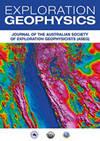Frequency-domain acoustic full waveform inversion with an embedded boundary method for irregular topography
IF 0.8
4区 地球科学
Q4 GEOCHEMISTRY & GEOPHYSICS
引用次数: 0
Abstract
In the implementation of full waveform inversion (FWI) to identify subsurface velocity distributions with land seismic data, which are often acquired in regions with irregular topography, wave equation-based modelling requires caution. In particular, when using the finite difference method (FDM), unwanted scattered waves are generated because irregular surfaces crossing a rectangular grid are discretized via a staircase approximation; hence, if the problems caused by this staircase approximation are disregarded, FDM-based FWI may fail due to the presence of undesirable wavefields. To resolve this problem, this study develops a 2D frequency-domain acoustic FWI technique using a 9-point FDM-based modelling scheme that includes an embedded boundary method (EBM). This study suggests a workflow for the whole EBM-based FWI process from the calculation of coefficients for the EBM-based 9-point FDM modelling to applying it to FWI for proper velocity updates. In numerical examples, using velocity models with a tilted surface and an arbitrarily fluctuating surface, we synthesize seismic data and verify the accuracy of EBM-based 9-point FDM modelling and its superiority over the conventional FDM by comparing it with wavefields derived from the spectral element method. Then, we show that our EBM-based FWI is able to estimate subsurface velocity distributions even though the model has irregular topography, which spoils the result of the conventional FWI.基于嵌入边界法的不规则地形频域声学全波形反演
在利用陆地地震数据识别地下速度分布的全波形反演(FWI)的实施中,基于波动方程的建模需要谨慎。陆地地震数据通常在地形不规则的地区获得。特别地,当使用有限差分法(FDM)时,由于通过阶梯近似对穿过矩形网格的不规则表面进行离散化,因此会产生不想要的散射波;因此,如果忽略由这种阶梯近似引起的问题,则基于FDM的FWI可能由于不期望的波场的存在而失败。为了解决这个问题,本研究开发了一种2D频域声学FWI技术,该技术使用基于9点FDM的建模方案,其中包括嵌入边界方法(EBM)。本研究提出了整个基于EBM的FWI过程的工作流程,从计算基于EBM 9点FDM建模的系数到将其应用于FWI以进行适当的速度更新。在数值算例中,使用具有倾斜表面和任意波动表面的速度模型,我们综合了地震数据,并通过将基于EBM的9点FDM模型与谱元法导出的波场进行比较,验证了其准确性及其相对于传统FDM的优越性。然后,我们表明,即使模型具有不规则的地形,我们基于EBM的FWI也能够估计地下速度分布,这破坏了传统FWI的结果。
本文章由计算机程序翻译,如有差异,请以英文原文为准。
求助全文
约1分钟内获得全文
求助全文
来源期刊

Exploration Geophysics
地学-地球化学与地球物理
CiteScore
2.30
自引率
0.00%
发文量
33
审稿时长
>12 weeks
期刊介绍:
Exploration Geophysics is published on behalf of the Australian Society of Exploration Geophysicists (ASEG), Society of Exploration Geophysics of Japan (SEGJ), and Korean Society of Earth and Exploration Geophysicists (KSEG).
The journal presents significant case histories, advances in data interpretation, and theoretical developments resulting from original research in exploration and applied geophysics. Papers that may have implications for field practice in Australia, even if they report work from other continents, will be welcome. ´Exploration and applied geophysics´ will be interpreted broadly by the editors, so that geotechnical and environmental studies are by no means precluded.
Papers are expected to be of a high standard. Exploration Geophysics uses an international pool of reviewers drawn from industry and academic authorities as selected by the editorial panel.
The journal provides a common meeting ground for geophysicists active in either field studies or basic research.
 求助内容:
求助内容: 应助结果提醒方式:
应助结果提醒方式:


